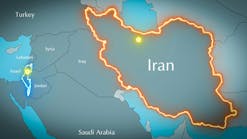- Due to a holiday in the U.S., data for this week's Industry Scoreboard are not available.
Don't look for OPEC to tinker much with its 24.52 million b/d quota at this week's ministerial meeting in Vienna.
It's just too early for that until it becomes clear when and how much oil Iraq will put on the market as a result of last month's accord with the U.N. over limited sales to fund humanitarian aid in that country (OGJ, May 27, Newsletter, and p. 30). Details of that agreement are still to be completed. With the likelihood that about 700,000-800,000 b/d of Iraqi oil will enter the market for 6 months in July or August, plus the rest of OPEC's overproduction estimated at more than 1 million b/d, signs are pointing to a softening of oil prices in the third quarter.
PaineWebber, however, worries that currently high oil prices may entice OPEC to boost production quotas at a time when non-OPEC output is slated to rise and U.S. inventories are rebuilding. The analyst sees spot WTI sliding to $17/bbl by the fourth quarter from $20.25 in the second quarter.
OPEC is not likely to deal directly with the Iraqi issue until the sales start-up is imminent. If oil prices by then have fallen enough to be worrisome, OPEC is likely to call an emergency meeting to revise quotas to accommodate the added Iraqi oil. At this week's meeting, however, look for a general statement of intent toward this end and no concrete action until that day comes.
More worrisome is how OPEC will react to Venezuela's proposal to redefine its quotas (OGJ, May 13, p. 35) to cover only what is produced for export. If OPEC wants to keep Caracas happy by taking this step, it may have to hike other members' ceilings as well. Even if that reflects only current production levels, it would send a bearish signal to oil markets, with a resulting slide in prices.
With a lessening of its pariah status as a result of the U.N. accord, Iraq is trying to drum up some business with its neighbors. Baghdad has offered to let Qatar use its pipeline network to export Qatari gas to Turkey and other Mediterranean nations. Turkey in the mid-1980s first proposed such a plan, involving Qatar's supergiant North gas field and further exports to Europe, but high costs and lack of markets scotched that proposal. Iraq says market changes warrant a fresh need for Qatari gas and using its approach would slash project costs to a fraction of the original $17 billion estimate. Qatar would need only to lay a 600 km subsea line to Iraq's island terminal at Fao to tie into Iraq's grid.
Suddenly, Russia's Sakhalin Island is an E&D hot spot. Mobil and Texaco 50-50 have signed a protocol after completing negotiations for a production sharing agreement on the 2,700 sq mile Kirinskiy block off the Far East island. If approved by the companies, the Kremlin, and Sakhalin oblast, the two firms will spend as much as $150 million on a 6 year exploration program to begin in 1997. Late last month, a Marathon group and Exxon marked progress on Offshore Sakhalin projects that could entail spending more than $10.3 billion (OGJ, May 27, Newsletter).
Competition is heating among prospective LNG projects off Australia.
A major upgrade of estimated reserves in Undan-Bayu gas/condensate field in the Timor Gap Zone of Cooperation between Australia and Indonesia has bolstered prospects for another LNG scheme. Proved, probable, and possible gas reserves are pegged at about 6 tcf, with condensate reserves of 420 million bbl and gas liquids totaling 365 million bbl. Based on data from five wells drilled on ZOCA 91-12 and 91-13 permits by two groups led by BHP and Phillips, the total reserve of 1.79 billion bbl of oil equivalent makes Undan-Bayu one of Australia's biggest finds. The field straddles both permits, leading the two groups to discuss unitization, a first off Australia. Under consideration are a pipeline to shore and a major LNG complex near Darwin or a smaller, lower cost LNG plant sited on an offshore platform or floater near the field. The high liquids content may spur early development of condensate. The project also could bring in gas from Santos' Petrel and Tern fields, with the total project rivaling the Woodside group expansion and Shell's Gorgon project off Western Australia.
A row between Elf and BVS, privatization agency for eastern Germany, over the cost of the refinery Elf is building at Leuna has spread to the European Union Commission (EUC). The commission has asked for all data related to BVS claims of inflated costs for the refinery, in which it is slated to take a 33% stake when the project is completed in fall 1997.
Elf says estimates made in a study by a BVS consultant are unreliable because it did not take into account high costs resulting from Germany's stringent environmental standards. Elf reckons project cost, determined by French and German engineering firms, at 3.2 billion deutschemarks ($2.2 billion) vs. the BVS study estimate of 1.9 billion deutschemarks ($1.3 billion). The dispute threatens viability of the refinery because Germany is subsidizing it, and EUC could withdraw its authorization for subsidies if they are found to be misused.
In a case that has implications on future oil and gas project conditions off California, a federal judge ruled May 28 that Santa Barbara County cannot forbid Exxon from using tankers outside the county's jurisdiction.
The county sued Exxon last year after it shipped some Santa Barbara Channel oil from its Las Flores Canyon processing plant via pipeline to the San Francisco Bay area, then by tanker past Santa Barbara to refineries in Los Angeles (OGJ, May 8, 1995, Newsletter). The county maintained Exxon had agreed in 1987 to transport all its oil produced locally by pipeline, except under certain specified conditions, in exchange for approving the processing plant.
Exxon said it only agreed not to use tankers from Santa Barbara, and the judge concurred, declaring the county's efforts to control transport beyond its borders unconstitutional. In the last year, support for the county's position eroded at state and federal levels when MMS approved Exxon's plan, limiting tankers to three per month, and California Coastal Commission declined to intervene.
EPA has set policy guidelines to cut or waive penalties for small businesses that make good faith efforts to correct violations under most of its rules.
The policy applies to firms with 100 employees or less but not to criminal conduct or when public health or the environment are seriously threatened. If the violation is corrected within 180 days-or 360 days using pollution prevention-EPA will eliminate any penalty. If the business meets all criteria but takes more time to correct the violation or if it obtains a significant economic benefit from the violation, EPA will waive as much as 100% of punitive fines but may seek to recover money the company saved through noncompliance.
Changing needs of gas pipeline customers and rapidly evolving gas markets are challenging the limits of traditional gas pipeline regulation, says Columbia Gas. To overcome those limits, it wants FERC to model regulatory reforms in the gas pipeline industry after recent changes in regulation of the telecommunications and railroad industries.
Four key events have created a demand for flexible, customized services by gas storage and pipeline companies, Columbia told FERC: the initiative by LDC customers to negotiate new rate models with state public utility commissions, unbundling of LDC services at the local level, emergence of power marketing, and continuing restructuring of the electric utility industry. Columbia claims customers want more flexibility and innovation than can be readily provided under Order 636. It proposes FERC consider differentiating between basic and enhanced services to allow the market to respond effectively. This way, FERC could continue to regulate pipeline basic services, assuring that costs of service are allocated fairly to all customers. Customers could purchase enhanced services based on their individual needs to supplement or replace their basic services. Terms and prices for enhanced services would be negotiated between the pipeline and its customers. Lower costs and better service to customers resulted from the use of this model in the telecommunications and railroad industries, Columbia noted.
Canadian energy executives expect continued strong demand and firm oil prices for 1996-97, according to an Arthur Andersen survey. Almost 75% of oil and gas company managers surveyed expect rising demand for crude and increased drilling activity. In the same survey a year ago, only 45% of executives polled expected an increase in crude demand. Companies surveyed also expect continuing strong gas demand but uncertain gas prices because of inadequate pipeline capacity to markets. The survey also showed companies are taking another look at prospects on Canada's East Coast where exploration activity is heating and the Hibernia oil project off Newfoundland is nearing completion.
Canadian Association of Petroleum Producers (CAPP) is also predicting strong drilling activity, noting the several projects on tap will increase pipeline capacity from western Canada to crude oil markets in the U.S. Midwest. CAPP recently revised its production forecast for an 8% hike during 1995-2000 to 2.2 million b/d.
Enron is close to wrapping up an agreement to lay an 800 km from Pande gas fields in Mozambique to a proposed iron ore reduction plant in South Africa, according to Johannesburg press reports. Total project cost, including the gas field development and iron ore plant, is put at $2 billion.
South African Business Day newspaper quoted an Enron official as saying a final heads of agreement between the two nations was imminent (OGJ, Nov. 6, 1995, Newsletter). The project would start up at yearend 1998 or early 1999.
Enron and Mozambique's state petroleum firm ENH would oversee the pipeline project and development of Pande fields, where 14 wells have found estimated reserves of 2.5-5.5 tcf. The line would extend from Pande, near the mouth of the Sabie River via Maputo and cross the border at Komatipoort.
Local political activism continues to bedevil major petroleum companies in developing countries.
Shell's Nigerian unit (SPDC) continues to get bad press.
Now the company is being stung to respond to claims about its views on 19 Ogoni protesters imprisoned by the ruling military junta. The junta last year executed nine Ogoni protesters after a brief, questionable trial that elicited worldwide condemnation, and observers fear the same fate for this year's 19. Shell disputed reports it endorsed the jailings and says it hopes for early release for the innocent and early justice and some clemency for the guilty. Shell also reiterated its commitment to return to Nigeria's Ogoni region for environmental cleanup efforts. The company left Ogoniland in 1993 after repeated attacks by Ogoni activists on company personnel and facilities. It notes three of five producing stations there have been severely vandalized by locals, resulting in oil spills that still must be remediated. Shell has been condemned by environmental lobbyists alleging negligence in environmental damage from Ogoni oil operations.
Meanwhile, Total and Unocal have reaffirmed their political neutrality in the controversy over Myanmar's human rights record, notably with regard to the construction of a $1 billion gas pipeline from Yadana gas field in the Gulf of Martaban off Myanmar to domestic and Thai markets.
A U.K. TV report claimed Myanmar's government used forced and child labor in recently building an extension to the notorious "death railway" Japanese occupation troops built during World War II that claimed the lives of thousands of POWs and civilians. Total and Unocal deny any involvement in that project, saying all pipeline equipment and supplies are coming via barge from Singapore.
Copyright 1996 Oil & Gas Journal. All Rights Reserved.

